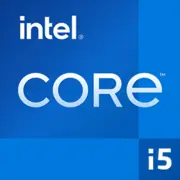Intel Core i5-12400F

Intel Core i5-12400F: Complete Review of the 2025 Processor
Architecture, Performance, and Build Recommendations
Key Specifications: Alder Lake on Intel 7
The Intel Core i5-12400F, released in late 2021, remains relevant in 2025 due to its successful balance of price and performance.
Architecture and Process Technology
- Codename: Alder Lake — the first generation of Intel's hybrid architecture, featuring a separation of Performance-cores (P-cores) and Efficient-cores (E-cores). However, the i5-12400F utilizes only 6 P-cores (12 threads), simplifying task management.
- Process Technology: Intel 7 (10nm Enhanced SuperFin) — an energy-efficient platform with a high transistor density.
- Frequencies: Base — 2.5 GHz, maximum in turbo mode — 4.4 GHz.
Performance
- Geekbench 6: 2186 (single-core), 8882 (multi-core). This level is sufficient for most games and work tasks. For example, in Cyberpunk 2077 (1080p, Ultra), the processor delivers a stable 90+ FPS when paired with an RTX 3060.
- Cache: 18 MB L3 — reduces latency when working with memory.
Key Features
- Support for PCIe 5.0 — relevant for future graphics cards and NVMe drives.
- Intel Thread Director technologies — optimization of task distribution among cores.
Compatible Motherboards: LGA 1700 Socket
Motherboards for the i5-12400F must have the LGA 1700 socket and 600/700 series chipsets.
Recommended Chipsets
- B660 / B760: Optimal choice. Supports DDR4/DDR5, PCIe 4.0, memory overclocking. Examples:
- MSI B760-A PRO ($130–150) — balance of price and functionality.
- ASUS TUF Gaming B760-Plus ($160–180) — improved VRM cooling.
- H610: Budget option, but without overclocking and with PCIe 3.0 limitations.
- Z690 / Z790: For enthusiasts, but excessive for the i5-12400F (the processor does not support overclocking).
Important Considerations
- Check support for DDR4/DDR5 (depends on the motherboard model).
- Update the BIOS before installation if the motherboard was released before 2023.
Memory: DDR4 vs DDR5
The processor supports both types but with nuances.
- DDR4-3200: Cheaper (about $50 for 16 GB), suitable for budget builds.
- DDR5-4800+: More expensive ($80–100 for 16 GB), but offers improved performance in high-bandwidth tasks (rendering, 4K editing).
Advice: For gaming, the difference between DDR4 and DDR5 is minimal (1–5% FPS). Choose DDR4 if you want to save money.
Power Supply: Power Calculation
With a TDP of 65W, the processor is not demanding on power supply, but it’s important to consider the graphics card:
- RTX 4060 / RX 7600 XT: A 550–600W power supply is sufficient (e.g., Corsair CX650M — $75).
- RTX 4070 / RX 7800 XT: 650–750W recommended (Seasonic Focus GX-750 — $120).
Important: Use cables with an 8-pin CPU connector and power supplies with an 80+ Bronze certification or higher.
Pros and Cons of the i5-12400F
Advantages
- Price: $150–170 (new, 2025) — 20% cheaper than Ryzen 5 7600X.
- Energy efficiency: Consumes up to 117W under load, easily cools down.
- Gaming performance: Matches more expensive models at Full HD/2K resolutions.
Disadvantages
- No integrated graphics (denoted by the "F") — requires a discrete graphics card.
- Does not support overclocking (unlike the K-series).
Usage Scenarios
Gaming
- Examples: Call of Duty: Warzone 2 (120 FPS at 1080p), Hogwarts Legacy (75–90 FPS).
- Advice: Pairing with an RTX 4060 or RX 7600 XT is an ideal balance.
Work Tasks
- Video editing in DaVinci Resolve: Rendering a 4K project takes 25–30 minutes (compared to 35+ minutes with i5-11400).
- Programming: Fast code compilation thanks to 12 threads.
Multimedia
Streaming via OBS without lag (using the card's NVENC).
Comparison with Competitors
- AMD Ryzen 5 7600X ($220): Better in multi-threaded tasks (+15%), but more expensive and requires DDR5.
- Intel Core i5-13400F ($180): +10% in performance, but higher TDP (148W).
Conclusion: The i5-12400F wins on price/performance ratio.
Build Tips
1. Cooling: The stock cooler is sufficient, but for quieter operation, consider the DeepCool AK400 ($35).
2. Case: Ensure proper ventilation (minimum of 2 fans).
3. Storage: PCIe 4.0 NVMe (e.g., Samsung 980 Pro 1TB — $90) for faster load times.
Final Conclusion: Who Should Choose the i5-12400F?
This processor is an ideal choice for:
- Gamers building a PC for $800–1000.
- Office users needing stability and multitasking capabilities.
- Enthusiasts upgrading old systems (e.g., from i5-9400F).
Why in 2025? Its low price, compatibility with DDR4, and lack of obvious weaknesses make it a "workhorse" for the mid-range segment.
Basic
CPU Specifications
Memory Specifications
Miscellaneous
Benchmarks
Compared to Other CPU
Related CPU Comparisons
Share in social media
Or Link To Us
<a href="https://cputronic.com/en/cpu/intel-core-i5-12400f" target="_blank">Intel Core i5-12400F</a>
